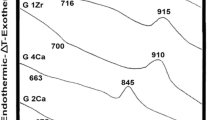Abstract
A systematic investigation on the fabrication of glass-mica composite materials from recycled colourless soda-lime glass powders and phlogopite-type mica powders has been conducted. Mixtures of two specific compositions of the glass-mica system were used and the investigation was based on several chosen processing parameters. When compacted powder samples were sintered at temperatures in the range 780 to 900° C, samples of one composition formed a composite material having a cellular structure; whereas samples of the other composition formed a composite material having a highly-dense ceramic structure. Sample evaluations showed that both the sintering temperature and the quantity of water which is added to the glass-mica mixtures as wetting agent in the powder compaction process are sensitive processing parameters. They can control the physical, mechanical and thermal properties of the glass-mica composite material. It was found that when glass-mica dry mixtures were prepared with the addition of a quantity of water equivalent to about 10% of the sample weight and sintered at the temperature of 850° C, the resultant composite material exhibited optimum physical, mechanical and thermal properties. The compressive strength and thermal insulating value of the glass-mica composite material with the densified structure are found to be superior to those of several conventional building materials, such as masonary products, lightweight concrete and soda-lime glass components. The experimental findings suggest that the glass-mica composite material is a potential structural element for building construction applications as it may contribute to energy conservation.
Similar content being viewed by others
References
N. M. P. Low, J. Mat. Sci. 15 (1980) 1509.
H. R. Shell and K. H. Ivey, U.S. Bureau of Mine Bull. 647 (1969) 197.
J. Borg and V. Vanek, Czech Patent 132, 610 (Jan. 15, 1969).
I. Ishii, T. Murokarmi and K. Ohtesu, Japan Kokai Patent 74-07,799 (Jan. 23, 1974).
Marietta Resources International Ltd., Technical Bulletin T-1, Fundamental Properties of Suzorite Mica (phlogopite), Sept. 15, 1976.
ASTM Standards, Designation C20-74.
ASTM Standards, Designation C177-77.
W. D. Kingery, “Introduction to Ceramics” (John Wiley, New York, 1960) p. 33.
H. Scholze, Glass Industry 47 (1966) 622.
I. B. Cutler, J. Amer. Ceram. Soc. 52 (1969) 11.
G. Adam and J. H. Gibbs, J. Chem. Phys. 43 (1965) 139.
J. F. Malloy, “Thermal Insulation”, (Van Nostrand Reinhold, New York, 1969) p. 189.
E. B. Shand, “Glass Engineering Handbook”, (Corning Glass Works, New York, 1955) p. 14.
T. Z. Harmathy and L. W. Allen, J. Amer. Concrete Inst. 70 (1973) 132.
Author information
Authors and Affiliations
Rights and permissions
About this article
Cite this article
Low, N.M.P. The effects of temperature, pressure and water on the preparation of glass-mica composite material. J Mater Sci 15, 2497–2507 (1980). https://doi.org/10.1007/BF00550753
Received:
Accepted:
Issue Date:
DOI: https://doi.org/10.1007/BF00550753




